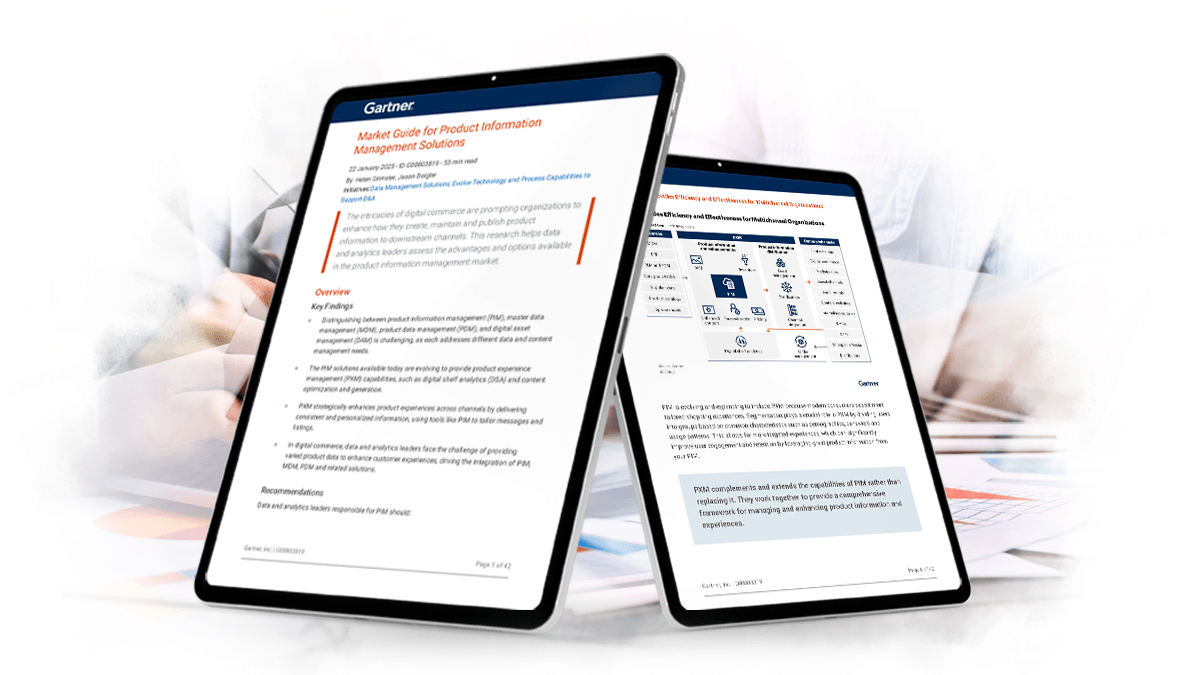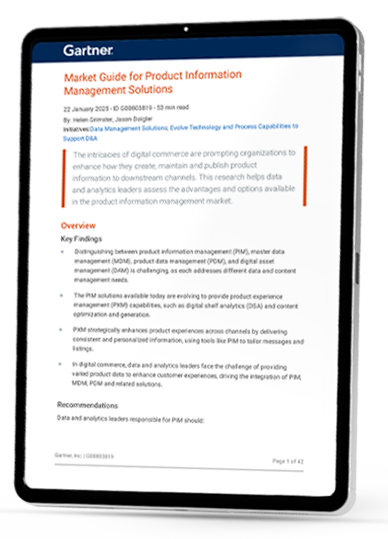5 Key Takeaways from Gartner® Market Guide for PIM Solutions (2025)

Table of Contents
- Why Read Gartner® Market Guide on PIM?
- 1. The Lines Between PIM, PXM, and MDM Are Blurring
- 2. AI-Powered Content Generation Is Reshaping PIM
- 3. Sustainability and Compliance Are Driving PIM Adoption
- 4. The Market Is Moving Toward Composable and API-First PIMs
- 5. PIM Is Becoming Essential for B2B Growth and Supplier Collaboration
- Final Thoughts
Choosing the right PIM system to manage your product information across multiple sales channels is a big decision.
It often means hours of demos, internal debates, and detailed evaluations to ensure you’re picking the best fit for your business. To make this process easier, Gartner® analysts have compiled a Market Guide for Product Information Management Solutions.
If you work in e-commerce, retail, manufacturing, or any B2B industry, this report is a must-read to get a clear overview of what to look for in a PIM solution in 2025.
In this blog post, I’ll break down the key takeaways from the Gartner® Market Guide and share my insights on what they mean in practice.
Why Read Gartner® Market Guide on PIM?
Two reasons.
First, Gartner® lists representative PIM vendors and their capabilities, giving you the insights you need to make the best choice.
Secondly, this Gartner® report goes beyond the basics of what a PIM does—it highlights how PIM has evolved into Product Experience Management (PXM), which doesn’t just store and organise data but actively enhances product experiences across all channels.

Download the Market Guide now to get the full market insights:

GARTNER® PIM MARKET GUIDE
2025 Market Guide for PIM Solutions
The 2025 Market Guide by Gartner® will help data and analytics leaders understand the benefits and choices in the PIM market.
Now, let’s explore other key takeaways from the Market Guide:
1. The Lines Between PIM, PXM, and MDM Are Blurring
The traditional distinctions between PIM, Master Data Management (MDM), and Product Experience Management (PXM) are fading.
While PIM remains the foundation for structured product data, businesses are increasingly integrating PXM capabilities like digital shelf analytics (DSA), content optimisation, and AI-driven personalisation to drive customer engagement and conversion.
⮕ What this means for you: If you’re evaluating a PIM solution, think beyond data management—consider whether you need a PXM-ready platform that can deliver superior product experiences.
By “superior product experience", I mean:
- Accurate and complete product information
- Consistent messaging everywhere
- Personalised and localised content
2. AI-Powered Content Generation Is Reshaping PIM
AI is no longer a futuristic add-on—it’s re-shaping how businesses manage product data. The report reveals that modern PIM vendors leverage AI-powered content creation, automated classification, and multilingual translations to streamline workflows and reduce manual effort.
⮕ What this means for you: AI integrated into your PIM can help your business scale product data management, delivering faster time-to-market, improved consistency, and hyper-personalised content across multiple channels. According to Bluestone PIM research, it’s also cost-effective.
To illustrate this, the Bluestone PIM team has created a calculator to highlight the difference between manual and AI-driven product enrichment.
Calculate the cost of using AI in PIM for product enrichment now:
Discover the cost difference between manual product data enrichment and AI-driven enrichment.
Number of products requiring description
Average Word Count per Product Description
Manual/Human Copywriting Cost per Word
Your Current Cost Estimation:
$ for human copywriting of words to create product descriptions.
The AI calculates costs based on the number of input and output tokens, with each token representing approximately four characters. The cost per token varies depending on the model used.
Basic GPT Model: Less powerful, lower cost, produces simpler or less detailed responses, and might be faster due to smaller size or fewer computations.
Advanced AI Model: More powerful, higher cost, produces higher-quality and more detailed responses, but could be slower because of increased computational complexity.
Pricing for AI models often decreases with each new release, making advanced processing more cost-effective over time.
Bluestone PIM AI Enrich estimation
- With Basic AI model $
- With advanced AI model $
3. Sustainability and Compliance Are Driving PIM Adoption
With stricter regulations and rising consumer demand for transparency, businesses must ensure their product data accurately supports sustainability claims and meets compliance standards.
Gartner® analysts predict that by 2026, over 50% of businesses will use AI-driven tools to monitor sustainability compliance.
⮕ What this means for you: If you operate in fashion, food, manufacturing, or consumer goods, investing in a composable PIM with built-in sustainability tracking capabilities can help future-proof your compliance efforts.
In my opinion, this will be crucial for companies selling products in the European market, as the upcoming Digital Product Passport regulation—set to take effect in 2026—will prohibit sales without a valid Digital Product Passport.
4. The Market Is Moving Toward Composable and API-First PIMs
PIM solutions are moving away from monolithic, on-premises applications toward cloud-native, API-driven platforms.
Gartner® highlights that businesses are adopting composable commerce architecture, with PIM solutions evolving to integrate seamlessly with e-commerce, ERP, CMS, and marketing automation tools.
⮕ What this means for you: Investing in an API-first, modular PIM ensures scalability, interoperability, and long-term adaptability as your business grows.
It’s no surprise—the API-first approach ensures flexibility, scalability, and a future-proof tech stack. API-first applications are built to integrate seamlessly with other IT components, giving businesses the freedom to develop their technology without limitations.
Many well-known tech companies are part of the API economy—Slack, Shopify, and HubSpot, to name a few.
5. PIM Is Becoming Essential for B2B Growth and Supplier Collaboration
PIM is no longer just a tool for retail and e-commerce—it is increasingly critical for B2B organisations, especially those handling large volumes of supplier data.
Analysts highlight that B2B companies often struggle with inconsistent product data from multiple suppliers and must invest in PIM solutions to streamline supplier onboarding and ensure high data quality.
⮕ What this means for you: If your business operates in B2B manufacturing, distribution, or wholesale, investing in a PIM with supplier data onboarding capabilities can enhance operational efficiency and improve product data consistency across all channels.
Automating supplier collaboration through a PIM can also reduce errors, speed up time-to-market, and improve customer trust.
Final Thoughts
Whether you’re selecting a new Product Information Management (PIM) system, upgrading an existing one, or exploring Product Experience Management (PXM) capabilities, Gartner® Market Guide for PIM Solutions (2025) provides expert insights to inform your next steps.
Don’t just manage product data—turn it into your competitive advantage. Download the report and take a proactive step toward a smarter, more efficient approach to product information.
I’m excited to share that Bluestone PIM has been recognised by Gartner® as a Representative Vendor in the PIM market!
We believe this recognition reflects our modern generative AI features, seamless API integrations, and versatile built-in applications—all designed to support diverse business needs across industries. Want to see the composable PIM in action? Let’s connect!
Schedule a personalised demo
Book a demo today and discover how Bluestone PIM gives you the features and flexibility to manage product information effortlessly—without the hassle.





